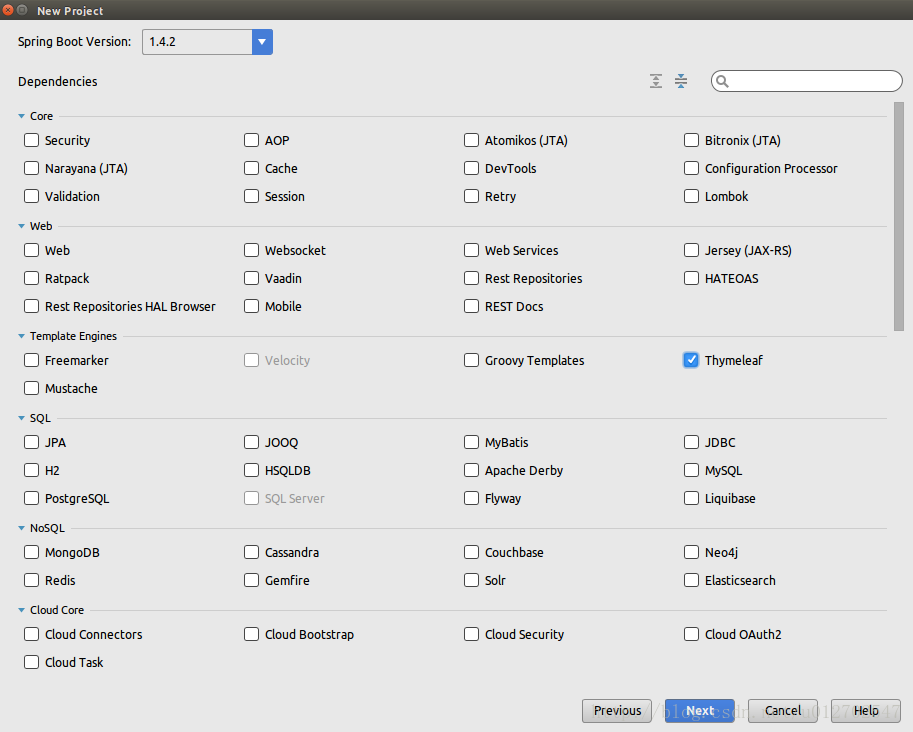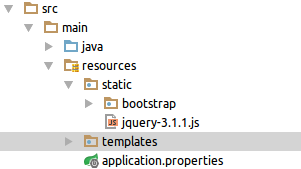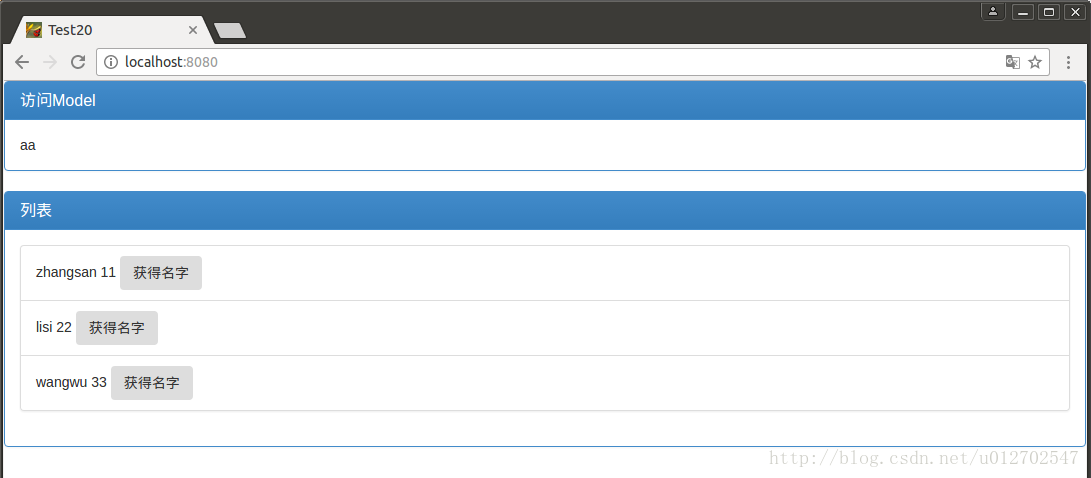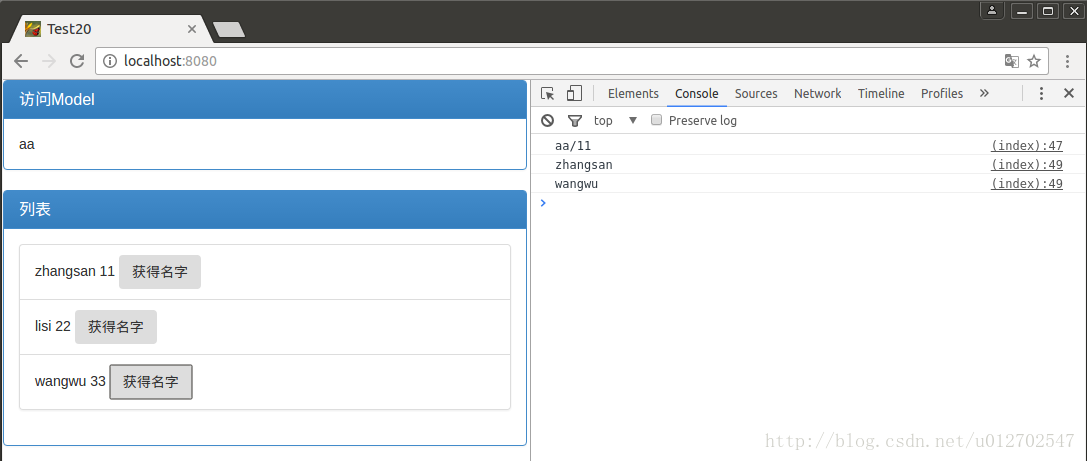详解使用Spring Boot开发Web项目
前面两篇博客中我们简单介绍了spring Boot项目的创建、并且也带小伙伴们来DIY了一个Spring Boot自动配置功能,那么这些东西说到底最终还是要回归到Web上才能体现出它的更大的价值,so,今天我们就来看一下如何使用Spring Boot来开发Web项目。当然,如果小伙伴对Spring Boot尚不熟悉的话,可以先参考一下这两篇博客:
1.初识Spring Boot框架
2.初识Spring Boot框架(二)之DIY一个Spring Boot的自动配置
Spring Boot 提供了spring-boot-starter-web来为Web开发予以支持,spring-boot-starter-web为我们提供了嵌入的Tomcat以及SpringMVC的依赖,用起来很方便。另外,我们这里还要用到模板引擎,我们做web开发可选的模板引擎还是挺多的,这里我主要使用Thymeleaf作为模板引擎,事实上,Spring Boot提供了大量的模板引擎,包括FreeMarker、Groovy、Thymeleaf、Velocity和Mustache,在 提供的这么多中它推荐使用Thymeleaf。Thymeleaf在使用的过程中通过ThymeleafAutoConfiguration类对集成所需要的Bean进行自动配置,通过ThymeleafProperties来配置Thymeleaf,包括前缀后缀什么的,我们可以查看ThymeleafProperties一段源码:
@ConfigurationProperties("spring.thymeleaf")
public class ThymeleafProperties {
private static final Charset DEFAULT_ENCODING = Charset.forName("UTF-8");
private static final MimeType DEFAULT_CONTENT_TYPE = MimeType.valueOf("text/html");
public static final String DEFAULT_PREFIX = "classpath:/templates/";
public static final String DEFAULT_SUFFIX = ".html";
private boolean checkTemplate = true;
private boolean checkTemplateLocation = true;
private String prefix = "classpath:/templates/";
private String suffix = ".html";
private String mode = "HTML5";
......
......
......
}
OK,从这一段源码中我们可以看到默认的页面后缀名为.html,前缀为classpath:/templates/,实际上也就是我们需要把html页面放到resources文件夹下的templates文件夹中。同时我们也看到了要如何修改这个配置,在application.properties文件中以spring.thymeleaf为前缀来配置相关属性。
创建Project
注意创建的时候要选择Thymeleaf作为依赖,这样创建成功的Project中将自动包含spring-boot-starter-web,如下图:

创建JavaBean
我一会要从后台传递数据给前台页面,数据的载体就是这个JavaBean,如下:
public class Person {
private String name;
private Integer age;
public Person() {
super();
}
public Person(String name, Integer age) {
super();
this.name = name;
this.age = age;
}
public String getName() {
return name;
}
public void setName(String name) {
this.name = name;
}
public Integer getAge() {
return age;
}
public void setAge(Integer age) {
this.age = age;
}
}
后台数据构造
在入口类中添加如下代码,由后台向前台页面返回两条数据,一个单个的Person对象,还有一个people对象是一个List集合,集合中放了3个Person对象,到时候我们直接将这两条数据在html页面上显示出来,代码如下:
@RequestMapping("/")
public String index(Model model) {
Person single = new Person("aa", 11);
List<Person> people = new ArrayList<>();
Person p1 = new Person("zhangsan", 11);
Person p2 = new Person("lisi", 22);
Person p3 = new Person("wangwu", 33);
people.add(p1);
people.add(p2);
people.add(p3);
model.addAttribute("singlePerson", single);
model.addAttribute("people", people);
return "index";
}
这里的代码都很简单,不必我多说了,就是返回给前台页面两个对象,一个singlePerson,一个people,另外,我们的前台页面叫做index.html。
引入相关的静态文件
这里我使用到了Bootstrap和jQuery两个库,当然这个并不是必须的,只是为了让我们显示的效果更好看一些,静态文件我们要放在src/main/resources/static目录下。
放置之后目录如下:

前台展示页面
刚才小伙伴们都看到了,默认情况下前台页面要放在src/main/resources/templates目录下,so,我们在该目录下新建文件就叫index.html,如下:
<html lang="en" xmlns:th="http://www.thymeleaf.org">
<head>
<meta charset="UTF-8" />
<title>Test20</title>
<link th:href="@{bootstrap/css/bootstrap.min.css}" rel="external nofollow" rel="external nofollow" rel="stylesheet" />
<link th:href="@{bootstrap/css/bootstrap-theme.min.css}" rel="external nofollow" rel="stylesheet" />
</head>
<body>
<div class="panel panel-primary">
<div class="panel-heading">
<h3 class="panel-title">访问Model</h3>
</div>
<div class="panel-body">
<span th:text="${singlePerson.name}"></span>
</div>
</div>
<div th:if="${not #lists.isEmpty(people)}">
<div class="panel panel-primary">
<div class="panel-heading">
<h3 class="panel-title">列表</h3>
</div>
<div class="panel-body">
<ul class="list-group">
<li class="list-group-item" th:each="person:${people}">
<span th:text="${person.name}"></span>
<span th:text="${person.age}"></span>
<button class="btn" th:onclick="'getName(\''+${person.name}+'\');'">获得名字</button>
</li>
</ul>
</div>
</div>
</div>
<script th:src="@{jquery-3.1.1.js}" type="text/javascript"></script>
<script th:src="@{bootstrap/js/bootstrap.min.js}" type="text/javascript"></script>
<script th:inline="javascript">
var single = [[${singlePerson}]];
console.log(single.name+"/"+single.age);
function getName(name) {
console.log(name);
}
</script>
</body>
</html>
关于这一段html文件我简单介绍一下,首先通过xmlns:th="http://www.thymeleaf.org"导入命名空间,在后期时候的时候,由于html本身是静态视图,在使用相关属性的时候加上th:前缀可以使之变为动态视图。th:href="@{bootstrap/css/bootstrap.min.css}" rel="external nofollow" rel="external nofollow" 表示引用Web静态资源。OK,这是head部分。body部分整体上分为了两大块,第一块显示我那个单独的Person对象,第二部分显示List集合中的Person对象。div的样式这个没啥好说的,照着Bootstrap的官网写就行了,th:text="${singlePerson.name}"表示访问model中singlePerson的name属性,th:if="${not #lists.isEmpty(people)}"表示判断model中的people集合是否为空,th:each="person:${people}"表示遍历people中的元素,这个和Java里的foreach差不多,person表示迭代元素。th:onclick="'getName(\''+${person.name}+'\');'"表示添加点击事件,点击事件由JavaScript来处理。th:inline="javascript"这样添加到的script标签可以通过[[${singlePerson}]]访问model中的属性。
如此之后,我们便可以运行我们自己的项目了,然后在浏览器中访问,结果如下:

点击Button也可以在浏览器控制台看到log输出:

OK,perfect!
Tomcat相关配置
上面几乎没做什么特别的配置,大部分都使用了SpringBoot提供的默认的配置方式。有的时候我们可能需要有一些自定义的配置,比如Tomcat的配置,很简单,和上上篇博客说的基本一致,有两种不同的配置方式:
在application.properties中配置
直接在application.properties中进行配置即可,如下:
server.port=8081#配置服务器端口,默认为8080 server.session-timeout=1000000#用户回话session过期时间,以秒为单位 server.context-path=/index#配置访问路径,默认为/ server.tomcat.uri-encoding=UTF-8#配置Tomcat编码,默认为UTF-8 server.tomcat.compression=on#Tomcat是否开启压缩,默认为关闭
在代码中进行配置
@Component
public class CustomServletContainer implements EmbeddedServletContainerCustomizer {
@Override
public void customize(ConfigurableEmbeddedServletContainer container) {
container.setPort(8080);
container.addErrorPages(new ErrorPage(HttpStatus.NOT_FOUND,"/404.html"));
container.setSessionTimeout(10, TimeUnit.MINUTES);
}
}
自定义类实现
EmbeddedServletContainerCustomizer接口,然后设置端口、设置错误请求页面、设置会话超时时间等,大家注意这里的404页面放在src/main/resources/static文件夹下,有了这个之后,当我访问一个不存在的页面的时候就会跳转到404.html页面了。
SpringMVC相关配置
虽然Spring Boot默认的配置很多情况都可以满足我们的项目需求,可是有的时候我们可能还是会需要更加灵活的SpringMVC配置,这个时候我们只需要自定义类继承自WebMvcConfigurerAdapter,然后使用@Configuration和@EnableWebMvc注解,这样我们会完全屏蔽掉Spring Boot的默认配置,但是正常情况下我们可能只是希望在Spring Boot已有默认配置的基础上再添加一些配置即Spring Boot提供的默认配置和我自定义的配置并存的情况,这个也简单,只需要去掉@EnableWebMvc注解就行了。如下代码:
@Configuration
//@EnableWebMvc//无需使用该注解,否则会覆盖掉SpringBoot的默认配置值
public class WebMVCConfig extends WebMvcConfigurerAdapter {
@Override
public void addViewControllers(ViewControllerRegistry registry) {
registry.addViewController("/hello").setViewName("/hello");
}
}
自定义Favicon
想要自定义favicon很简单,只需要将自己的favicon.ico文件放置到src/main/resources目录下即可,重新运行项目,再看浏览器左上角图标就会变了。如下:

本案例下载地址: 本案例GitHub地址
以上就是本文的全部内容,希望对大家的学习有所帮助,也希望大家多多支持呐喊教程。
声明:本文内容来源于网络,版权归原作者所有,内容由互联网用户自发贡献自行上传,本网站不拥有所有权,未作人工编辑处理,也不承担相关法律责任。如果您发现有涉嫌版权的内容,欢迎发送邮件至:notice#yiidian.com(发邮件时,请将#更换为@)进行举报,并提供相关证据,一经查实,本站将立刻删除涉嫌侵权内容。

